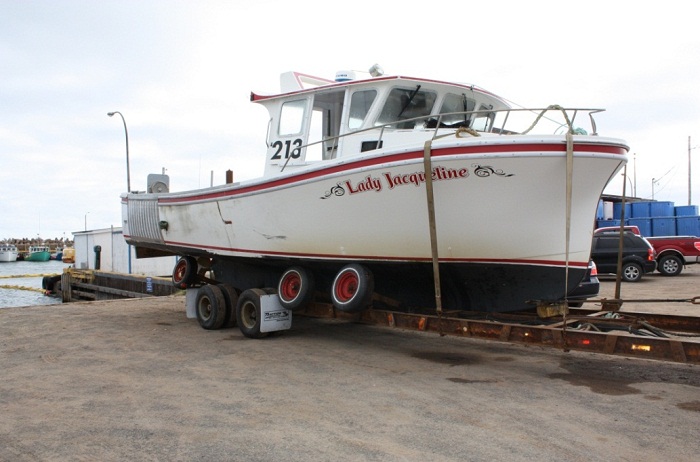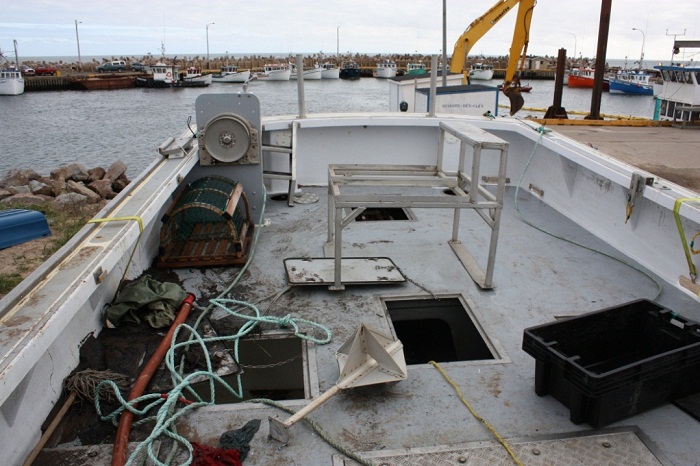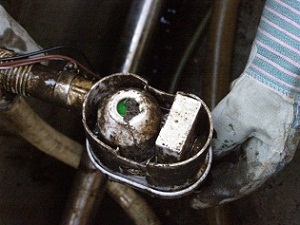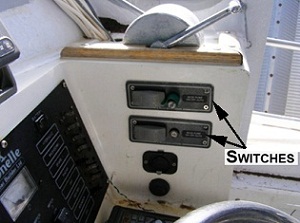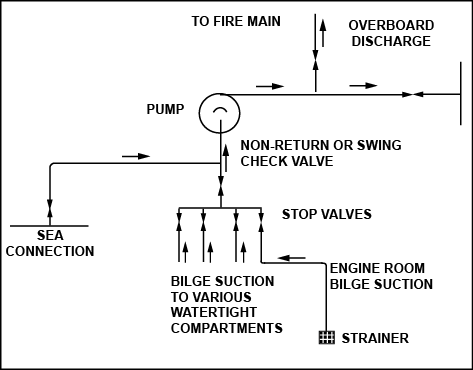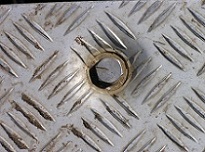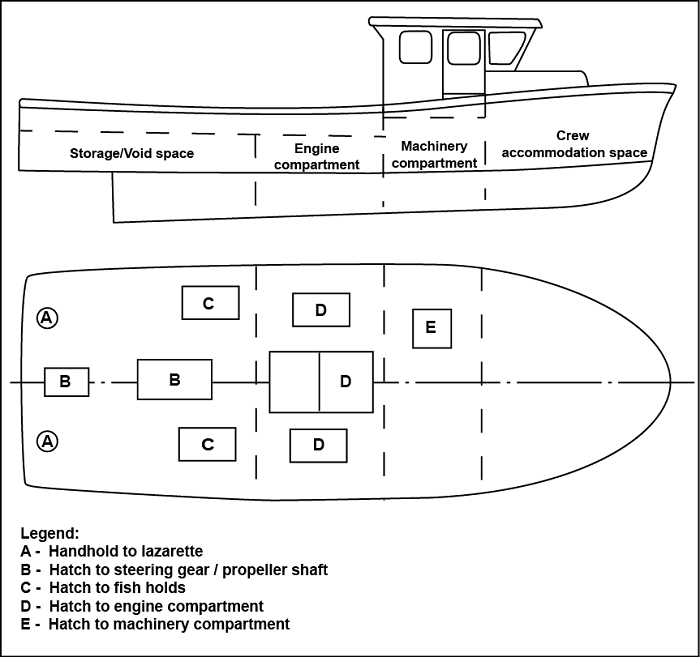Taking on water and abandonment
Small fishing vessel Lady Jacqueline
Off Cap du Phare, Îles-de-la-Madeleine, Quebec
The Transportation Safety Board of Canada (TSB) investigated this occurrence for the purpose of advancing transportation safety. It is not the function of the Board to assign fault or determine civil or criminal liability. This report is not created for use in the context of legal, disciplinary or other proceedings. See Ownership and use of content. Masculine pronouns and position titles may be used to signify all genders to comply with the Canadian Transportation Accident Investigation and Safety Board Act (S.C. 1989, c. 3).
Summary
On 21 May 2011, at approximately 1255 Atlantic Daylight Time and one-half mile off Cap du Phare, Îles-de-la-Madeleine, Quebec, the small fishing vessel Lady Jacqueline took on water and was abandoned with a load of lobster on board. The operator and the 2 crew members were rescued by fishing vessels from l’Étang-du-Nord. The crew exhibited symptoms of mild hypothermia; none of them were injured.
Factual information
Particulars of the vessel
| Name of vessel | Lady Jacqueline |
| Registry number | 825187 |
| Port of registry | Cap-aux-Meules, QC |
|---|---|
| Flag | Canada |
| Type | Small fishing vessel |
| Gross tonnage | 11.0 |
| LengthFootnote 1 | 10.59 m |
| Builder | Donelle Boat Builder Ltd, Shemogue, NB |
| Built | 2002 |
| Propulsion | One diesel engine (235 kW) driving a single fixed-pitch propeller |
| Cargo | 2 tanks of live lobster, 135 kg |
| Crew | 3 |
| Registered owner | Owner/Operator, Fatima, QC |
Description of the vessel
The Lady Jacqueline is a Northumberland-style fishing vessel used mainly for crab and lobster fishing. The glass-reinforced plastic hull below deck is subdivided by 3 transverse non-watertight bulkheads that enclose, from forward, the crew accommodation space, the machinery compartment, the engine compartment, and the storage/void space (Appendix A).
Above deck, the entry to the enclosed wheelhouse from the working deck is through a sliding door on the starboard side. The machinery compartment is located below the wheelhouse and is accessed through a hatch in the wheelhouse. Access to the engine compartment is through a hatch with 2 covers located on the working deck.
Many Northumberland-style fishing vessels are built as undecked vessels, with buoyancy largely determined by the watertight hull, to the full height of the gunwales. The Lady Jacqueline , however, was built as a decked vessel and as such incorporated a watertight deck and freeing ports. The working deck is kept watertight by closing and battening down the flush-fitting covers of the 7 hatches and 2 handholes. The deck is surrounded by a solid bulwark, forming a well. The bulwark is fitted with 3 freeing ports in each side and 2 in the aft end. One duct vent made of fibreglass is fitted on each side of the bulwark just aft of the wheelhouse for the venting of the engine compartment. On the day of the occurrence, 2 unsecured lobster tanks, each filled with approximately 1 m³ of water, were located on the aft end of the working deck.
The vessel is powered by a marine diesel engine with a reversible reduction gearbox driving a single fixed-pitch propeller and fitted with a single-plate centreline rudder. Two fuel tanks are fitted on the port and starboard sides of the storage space at the stern. The bilge pumping arrangement consists of 2 pumps: one mechanical pump, driven by the main-engine, used either for deck washing or for bilge pumping, and one electrical pump used only for bilge pumping. There is no high water level alarm fitted in the bilges. The vessel is fitted with the navigation and electronic equipment typically found on most recently built small fishing vessels.
History of the voyage
On 21 May, in the early morning, the operator, who was also the owner, and 2 deckhands arrived on the Lady Jacqueline . The vessel was secured in l’Étang-du-Nord fishing harbour, Îles-de-la-Madeleine, Quebec.
At 0430,Footnote 2 after the operator started the engine and checked the bilges, the vessel departed in time for the daily opening of the lobster fishery. At around the same time, other vessels also departed for the fishing grounds, although it was reported that some vessels chose not to leave due to the strong breeze from the northeast. At 0500, approximately 5 miles from shore, the crew of the Lady Jacqueline began hauling and emptying their first traps. As the hauling winch was located on the starboard quarter, the operator used astern propulsionFootnote 3 to ensure the deckhands could easily haul the traps. This maneuver had the result of exposing the vessel’s stern to waves of 2 to 2.5 m, which caused water to ship through the freeing ports on the stern and starboard quarter. As the vessel proceeded from one string of traps to another, the crew occasionally looked at the bilges to check the level of water because there was continuous ingress of water from an unknown source. At approximately 1100, the crew checked the bilge condition and noted that it was dry.
At 1230, the Lady Jacqueline was still fishing at approximately one-half mile off Cap du Phare, with a load of approximately 135 kg of lobsters in the 2 tanks. The crew hauled one of their last traps. At that time, most of the other fishing vessels had already returned to l’Étang-du-Nord.
At approximately 1235, a deckhand noticed that the shipped water was staying on the working deck and advised the operator. The operator also noticed that the vessel was sluggish. A deckhand lifted one of the engine compartment hatch covers, which was unsecured, and saw that the compartment was approximately ¾ full with water. The operator turned on the main engine-driven pump but it was unable to cope with the ingress of water. Soon after, he turned the vessel and proceeded towards shore. After approximately 3 minutes, however, the engine stopped. At approximately 1240, the operator used the very high frequency (VHF) radiotelephone channel 6 to alert vessels in the vicinity that the Lady Jacqueline was sinking and needed immediate assistance.Footnote 4 Five fishing vessels alongside in l’Étang-du-Nord heard the call and departed immediately for the occurrence site. The crew of the Lady Jacqueline donned lifejackets over their work clothes and moved to the fore deck since the working deck was now submerged.
At approximately 1255, the deckhands, concerned that the vessel would capsize, jumped into the water. However, the operator remained on the vessel. Shortly after, the operator entered the water when he saw other fishing vessels coming to his rescue. At 1300, the operator was recovered by the fishing vessel Le Galet Rouge. One deckhand was picked up by the fishing vessel Gabriel Danik and the other deckhand was picked up by the fishing vessel l’Imprevu II.Footnote 5 At 1324, Le Galet Rouge arrived in l’Étang-du-Nord with the operator. The other fishing vessels arrived in port shortly thereafter with the other rescued crew. The crew were transported to the Cap-aux-Meules hospital and discharged later that same day.
The Lady Jacqueline was abandoned in approximate position 47°23.3′ N 061°57.8′ W (Appendix B). The partially submerged vessel drifted overnight and was subsequently towed and salvaged to l’Anse-à-la-Cabane.
Injuries to persons
The operator and the deckhands exhibited symptoms of mild hypothermia but were not injured.
Damage to the vessel
After recovery, the hull was examined and was found to be intact, but the machinery and equipment had extensive water damage. The lobster tanks were lost overboard. Only one of the 2 hatch covers to the engine compartment (the aftermost) was found to be secured to the deck opening. The remaining unsecured covers were found on deck, attached by their safety chain, but not in place (Photo 2). The vessel was subsequently repaired and put into operation.
Environmental conditions
On the morning of the occurrence, there was a strong northeasterly breeze of 22–25 knots, with gusts of 30–33 knots. Waves were 2–2.5 m from the northeast. The water temperature was approximately 5ºC. At 1300, the visibility was good and the air temperature was 3ºC.
Personnel certification and experience
The operator had over 50 years of fishing experience and had been sailing on the Lady Jacqueline since 2003. He received training in order to obtain his Fishing Mate certificate in 1971, although this was no longer valid. He was not required to hold a certificate of competency by regulation. He did not hold a Marine Emergency Duties (MED) certificate with respect to basic safety training, although this was required by regulation.Footnote 6
One deckhand held a Fishing Master Fourth Class certificate and had approximately 22 years of fishing experience on different vessels. The other deckhand held no certificate and had approximately 3 years of fishing experience on the Lady Jacqueline.
Marine emergency duties training
The purpose of the marine emergency duties (MED) training program is to provide seafarers with an understanding of the hazards associated with the marine environment and with their vessel. It also provides, through approved shore-based courses, training in the skills that seafarers require to cope with such hazards, to the extent appropriate to their functions on board. Among other things, MED trains seafarers on:
- emergencies associated with the marine environment, such as equipment failure, weather conditions, flooding, persons overboard;
- action to take upon discovering an emergency situation, e.g., flooding;
- actions to take when called to an emergency, as well as equipment to wear such as suitable clothing, lifejackets or immersion suits; and
- actions to take to increase chances of survival and rescue.Footnote 7
MED training also enhances the overall safety awareness of the crew.
Small fishing vessel inspection program
Fishing vessels not exceeding ross tonnage have to comply with the Small Fishing Vessel Inspection Regulations, but they are not required to have an inspection certificate issued by TC. Nonetheless, they may be subject to inspections by TC for compliance with the regulation.
A small fishing vessel inspection program was established by TC Service Centre in Rimouski, Quebec, in 1999 with the aim of improving the safety of local fishing vessels not exceeding 15 gross tonnage. Participation in the program was voluntary for vessel owners. In 2009, TC Quebec Region estimated that of all fishing vessels in their region, 53%, or 330 vessels, were participating in the program.
Vessel inspection
The Lady Jacqueline was under 15 gross tonnage and therefore was not required to have a mandatory inspection or be issued a certificate by Transport Canada. However, the vessel must still meet regulatory requirements and may be subject to inspection.
On 07 August 2003, the Lady Jacqueline was inspected by a TC Marine Safety Inspector under the new voluntary program and in accordance with the applicable Canada Shipping Act, 2001 and supporting regulations. Not being subject to mandatory certification, a letter of compliance was issued and was valid until 30 April 2004.
The letter of compliance stated that the vessel was to operate within 20 nautical miles from shore in areas where ports of refuge did not exceed 100 nautical miles. This geographical limitation took into account the vessel’s level of manning, equipment and activities. On 26 February 2007, approximately 4 years after the vessel was last inspected, TC sent a letter to the operator of the Lady Jacqueline inviting him to carry out a self-inspection before the following fishing season and to complete a self-inspection form and return it to TC. This form was accompanied by a self-inspection guide. There is no record indicating that a self-inspection was done or that the form was returned to TC.
Lifesaving equipment
Lifesaving equipment on board the Lady Jacqueline included 4 approved lifejackets and 1 approved lifebuoy fitted with a line. There was no liferaft, no re-boarding device, and no immersion or anti-exposure work suits on board; none of this lifesaving equipment was required to be on board by regulation.
Bilge pumping arrangement on the vessel
When the Lady Jacqueline was constructed, the bilge pumping arrangement consisted of 3 pumps: one mechanical pump used either for deck washing or for bilge pumping, and 2 electrical pumps used only for bilge pumping. At the time of the occurrence, there was a mechanical pump but only one electrical pump installed on board, as the other one had been removed and not replaced. It is not known when the second electrical pump had been removed.
Mechanical pump arrangement
The mechanical pump, used primarily for deck washing, was fitted with a 3-way valve that permitted suction from either the sea or the bilge (Photo 3 and Figure 1). The valve was situated in the engine room, approximately 75 cm below the deck. Access to the valve was through the main engine forward hatch cover. There was no indication on the valve of the direction from which the valve was taking suction. Post-occurrence examination of this valve showed that it was positioned such that it was open approximately 80% to the bilge and 20% to the sea (Photo 4). The ball of the valve was rusted in the position in which it was found after recovery, indicating that the valve had not been operated for a long time.
The sea connection was fitted without a shut-off valve. The bilge suction was fitted without a strainer or a non-return valve to prevent back-flooding. The pump discharge was only through the deck wash hose that was fitted with a nozzle, found in the closed position after the vessel was recovered. A schematic of the arrangement is shown in Figure 1.
The switch for the mechanical pump, labeled "Wash Down", was located on the control panel in the wheelhouse, and had 2 positions: on or off. It was found in the off position when the vessel was recovered.
Electrical pump arrangement
During the 2003 inspection, there were 2 electrical pumps fitted on the vessel. At the time of the occurrence, only 1 electrical pump was fitted on the keel, low in the skeg in a narrow space underneath the propulsion shaft. The position of the pump is shown in Figure 2 and Photo 5.
Figure 1The pump had 2 running modes: manual and automatic, and was usually kept in the automatic mode during the operation of the vessel. The pump had been manufactured in November 2010 and was installed by the operator in April 2011, before the opening of the fishing season. The manufacturer’s instructions specified that the mounting base of the pump, which also served as a strainer, be fastened to the lowest point of the bilge by screws and that the housing be clipped onto the base. It also warned of the importance of regularly cleaning the impeller and float switch.
When the pump was installed, the mounting base was removed because of the reduced space available in the skeg. Examination of the pump after the occurrence found that the mounting base was not in place and the electrical pump was jammed into place. The overboard discharge for the pump was not fitted with a non-return valve (Figure 3).
The piping and through-hull fitting for the second electrical pump was in place but the pump had been removed and was kept on board in a locker as a spare unit. Most of the piping and through-hull fittings for the bilge pumping system were constructed of plastic or rubber, which offers very little protection in the event of a fire and has low mechanical strength.
The 2 switches for the electrical pumps were located to the right of the wheel and below the throttle. These switches had 3 positions: on (manual), off, and automatic. Both switches were found in the off position during post-occurrence examination (Photo 7). The investigation could not determine when the switches were turned off.
The post-occurrence examination and testing of the electrical pump found that the impeller of the pump was about 50% covered with Olefin fibre, which is commonly used in the manufacture of rope (Photo 6).Footnote 8
Examination and testing of the electrical pump revealed the following:
- The pump was not installed using the provided mounting base, which also serves as a strainer, as specified by the manufacturer. This allowed solid materials in the bilges to interfere with the impeller, potentially causing a motor shaft imbalance that may have affected the integrity of the motor shaft seal.
- Water and silt penetration into the pump’s inner housing contaminated and corroded the pump’s circuit board, its components and the motor.
- The pump’s efficiency in both operating modes was reduced due to damage to the circuitry and motor caused by water and silt penetration.
- The pump failed to operate as designed in its automatic mode due to water and silt penetration. The pump continued to run even when not immersed in water.
There was no evidence of regular maintenance of the bilge pumping system.
The stern tube gland, rudder post gland and engine wet exhaust were examined after the occurrence and were found to be in good condition. There was no significant ingress of water originating from these components.
Recommended bilge pumping arrangement
In 2002, as result of a number of occurrences and loss of life, TC issued a Ship Safety BulletinFootnote 9 concerning the importance of bilge pumping systems and early detection of any leakage into the hull. The Ship Safety Bulletin states that operators should review and ensure that:
- bilge pumping systems are designed to adequately address the risks inherent to the vessel design and its intended operations;
- bilge pumping systems are easily accessible for operation and maintenance;
- there is a means of early detection of water levels in all bilges and spaces below the waterline not readily observable from the helm. Bilge water level indicators should have a common audible alarm and a light for each indicator;
- the vessel has a maintenance program that ensures bilge pumping systems are reliable;
- there are operating procedures that routinely test bilge pumping and bilge alarm systems;
- there are operating practices that provide crew with the necessary training and familiarity with bilge pumping and alarm systems operation.
The Ship Safety Bulletin further notes that bilge pumping systems are to be installed and maintained in accordance with the manufacturer's instructions and applicable regulations and standards.
In 2003, TC issued its publication TP 10038, recommending the bilge pumping arrangement shown in Figure 4 below. Such an arrangement is normally comprised of at least one pump; a sea connection valve; a non-return valve installed on the bilge suction line to prevent back-flooding or ingress of water a strainer at each bilge suction line; and an overboard discharge valve.
At the time of the occurrence, there were no regulatory requirements concerning the bilge pumping arrangement of a small fishing vessel not exceeding 15 gross tonnage.
There are also international guidelines for operators of small fishing vessels. For example, according to the IMO Voluntary Guidelines for the Design, Construction and Equipment of Small Fishing Vessels (2005), “Arrangements should be provided for draining any watertight compartment on a vessel under all service conditions. (…) Bilge and ballast pumping systems should be arranged so as to prevent water passing from the sea into holds or into machinery spaces.”Footnote 10 IMO also approved, in 2010, the Safety Recommendations for Decked Fishing Vessels of Less than 12 Metres in Length and Undecked Fishing Vessels that also outlined recommended arrangements for bilge pumping systems.Footnote 11
Hatch covers
There were a total of 9 flush-deck openings (7 rectangular-shaped hatches and 2 round-shaped handholes) on the working deck of the Lady Jacqueline (Appendix A and Photo 8). Hexagonal bolts connected to dogs on the underside of the hatch covers were used to secure them (Photo 9 and Photo 10). Most of the hatches had 6 hexagonal dog bolts with relatively large spacing between the bolts. The hexagonal bolts, approximately 15 mm in diameter, were recessed into the chequered plating.
For the hatch cover to be secured watertight, the bolts had to be tightened individually because none of the covers had quick-action closing devices. To turn the hexagonal bolts to set the dogs, the crew used a tool with a 12-point socket. However, the bolts examined showed no evidence of use and most of the dogs were found rusted open (Photo 10). The rubber gaskets around the hatch covers were in place and showed no sign of excessive deterioration that could affect their watertight integrity.
Safe operating procedures and practices
According to the Canada Shipping Act, 2001, section 113, every crew member on board a vessel shall carry out their duties and functions in a manner that does not jeopardize the safety of the vessel or of any person on board.
The operator and crew of the Lady Jacqueline had years of fishing experience, yet a number of unsafe practices and conditions were identified in this occurrence:
- There was a continuous ingress of water below the waterline but the crew did not investigate to determine the source.
- The 3-way valve for the mechanical pump was left partially open to the sea, allowing continuous ingress of water in the bilge while the pump was not in service.
- There was a significant reduction of pressure in the deck wash hose but the cause of it was not identified.
- The electrical pump was not installed in accordance with the manufacturer’s instructions.
- The electrical pump was used to manage continuous water ingress, although it was not designed for this purpose.
- There was no regular maintenance to clean the bilge suctions.
- The hatch covers were left unsecured while at sea.
Emergency procedures and crew familiarization
The Canada Shipping Act, 2001 requires authorized representatives of Canadian vessels to develop procedures for the safe operation of the vessel and for dealing with emergencies.Footnote 12 Furthermore, the Marine Personnel Regulations require that a vessel’s master be provided with written instructions ensuring that crew members become familiar with safety equipment, operations and duties, and that they be provided with vessel-specific familiarization training.Footnote 13
No such procedures were in place on the Lady Jacqueline ; the crew had not developed any procedures to cope with situations such as flooding, nor had they been familiarized with some of the vessel’s critical safety equipment such as the bilge pumping system.
TC recommends and encourages the application of safety management principles for the operation of all vessels in the Canadian fleet, and reminds vessel owners and operators that the Canada Shipping Act, 2001 and Marine Personnel Regulations hold them responsible for providing written instructions and procedures for their crews. TC is also developing new fishing vessel safety regulationsto update the current requirements for owner responsibility and compliance with regards to maintenance of the vessel, safe operating procedures and modifications to the vessel.
Outstanding board recommendations
Past occurrences investigated by the TSB have raised similar safety concerns to those of the Lady Jacqueline. The following Board recommendations were made in response to these past occurrences and have not yet been found Fully Satisfactory:Footnote 14
In December 1990, 3 members of the fishing vessel Straits Pride II who were forced to abandon the vessel were wearing only winter clothing with lifejackets and lost their lives in the cold water.Footnote 15 Following the investigation, the Board recommended that:
The Department of Transport expedite its revision of the Small Fishing Vessel Safety Regulations which will require the carriage of anti-exposure worksuits or survival suits by fishermen.
Transportation Safety Recommendation M92-07
TC’s response as of December 2011 indicates that the proposed fishing vessel safety regulations will require small fishing vessels to carry immersion suits or thermal protective lifejackets. It is anticipated that these regulations will be published in the Canada Gazette, Part II, in the second quarter of 2013. The response to this recommendation was assessed as Satisfactory Intent by the Board.Footnote 16,Footnote 17
In November 1998, the scallop dragger Brier Mist took on water.Footnote 18 Since there were no watertight seals on the vessel hatch covers and no means of effectively securing them to the coaming, the vessel eventually lost all reserve buoyancy from downflooding and sank. Consequently, the Board recommended that:
The fishing industry and the Department of Transport give increased attention to small fishing vessel hatch covers to help ensure that these covers are watertight and can be effectively secured.
Transportation Safety Recommendation M00-06
In December 2010, TC responded by indicating that a risk-based monitoring and inspection regime for small vessels was being developed and work was being done to develop tools for the small fishing vessels such as guidance notes and checklists. Furthermore, in December 2011, TC indicated that they were continuing to attempt to increase the awareness of TC inspectors and owners of small fishing vessels regarding the need for watertight covers. The response to this recommendation was assessed as Satisfactory Intent by the Board.
In August 2002, the fishing vessel Cap Rouge II capsized.Footnote 19 The investigation determined that no regular emergency drills had been conducted on board, and no concrete emergency procedures had been laid out prior to the occurrence. Furthermore, the vessel’s stability had been reduced by the weight of equipment, deterioration of watertight seals on lazarette and handhole covers, and operation with the deck awash. Consequently, the Board recommended that:
The Department of Transport, in collaboration with the fishing community, reduce unsafe practices by means of a code of best practices for small fishing vessels, including loading and stability, and that its adoption be encouraged through effective education and awareness programs.
Transportation Safety Recommendation M03-07
In December 2011, TC reiterated that the Canada Shipping Act, 2001 placed increased emphasis on the responsibility of the vessel owner, master and/or authorized representative for safety. Work also continues on the proposed new fishing vessel safety regulations, which are anticipated to be published in The Canada Gazette, Part II in the second quarter of 2013. The Board assessed the response to this recommendation as Satisfactory Intent.
Fishing vessel safety
On 16 March 2010 and again in June 2012, the Board released its Watchlist, identifying those critical safety issues investigated by the TSB that pose the greatest risks to Canadians. One of these critical safety issues was the loss of life on fishing vessels. With an average of nearly 13 fatalities per year between 1999 and 2011, the Board remains concerned about vessel modifications and their impact on stability; the use and availability of lifesaving equipment; regulatory oversight; the impact of fishing resource management plans and practices; and as the lack of both a safety culture and a code of best practices. The Watchlist highlights the need for the industry to adopt and promote safe operating procedures and practices to increase the safety knowledge of fishing vessel operators.
In August 2009, the Transportation Safety Board launched an in-depth safety issues investigation (SII) into fishing vessel safety in Canada. The investigation report,Footnote 20 released in 2012, provides an overall, national view of safety issues in the fishing industry, and reveals the complex relationships and interdependencies amongthe systemic safety issues it identifies.
The safety issues investigation report emphasizes that to obtain real and lasting improvement in fishing safety, the interactions between and among the identified safety issues must first be acknowledged, and the issues then be addressed in a coordinated manner. Four of the 10 systemic issues identified by the SII as affecting the safety of fishing vesselswere found in this occurrence: stability, lifesaving appliances, training, and safe working practices.
Transport Canada provides regular updates on progress on the new regulations and other safety actions related to TSB recommendations and Watchlist items.
Analysis
Events leading to the abandonment
Maintaining the watertight integrity of the hull and deck of a small fishing vessel is one of the elements that ensures the seaworthiness of the vessel for its intended operation. Closing and securing hatch covers prior to departure and shutting off valves connected to the sea will prevent water ingress above and below deck.
On the Lady Jacqueline, the 3-way valve for bilge pumping was left partially opened to the sea. As there was no shut-off valve at the sea connection and no non-return valve on the bilge suction line, the vessel would continuously take on water below the waterline. This ingress would then have to be pumped out by the electrical pump. However, a post-occurrence examination of the pump revealed that its efficiency was reduced due to partial clogging and water and silt penetration into its inner housing. Given that the crew had not seen any accumulation of water until the last visual inspection of the bilges, it is likely that the reduced pumping efficiency was sufficient to cope with the rate of ingress of water as long as the pump was functioning.
On the Lady Jacqueline, it was common practice while hauling the lobster traps to manoeuver the vessel with its stern exposed to the wind and waves. As the waves were approximately 2–2.5 m high on the day of the occurrence, water washed the deck through the freeing ports. Sometime during the approximately 90 minutes between the last visual inspection of the bilges and when the crew noticed that the shipped water was staying on deck, the electrical pump likely ceased to function.
The Lady Jacqueline had departed for the fishing grounds with its hatch covers in place but unsecured. As water progressively flooded the hull through the open valve, resulting in a reduction of the vessel’s freeboard, the shipped water downflooded into the bilges via the unsecured hatches. At 1235, when the crew realized that the bilges were flooded, the operator decided to turn the vessel towards shore. The operator switched on the mechanical pump using the wash down switch on the control panel but it was unable to cope with the rate of ingress, the water level likely being too high for the capacity of the pump. When the engine ceased to function and the water level continued to rise, the crew donned their lifejackets and abandoned the vessel.
Bilge pumping arrangement
It is essential for safety that the vessel have efficient means to prevent the ingress of water into the hull or its accumulation on deck in order to maintain watertight integrity. In order to do so, among other things, all sea connections should be fitted with efficient and accessible means to prevent water from entering the hull. The sea inlets should be fitted with valves that have a positive means of closing from a readily accessible position, and these valves should be provided with an indicator showing whether they are open or closed. Overboard discharges passing through the hull should also be fitted with a non-return valve.
Although vessels are constructed to prevent ingress of water, in cases where ingress does occur it must be remedied or at least mitigated. To do this, vessels are outfitted with a bilge pumping system. This system, however, must be well designed, constructed and operated by crew.
When comparing the bilge pumping arrangement of the Lady Jacqueline as shown in Figure 1 with the recommended bilge pumping arrangement in Figure 4, the following items were noted:
- There was no shut-off valve at the sea connection to allow the crew to isolate the system when required.
- The 3-way valve for the mechanical pump was not readily accessible for operation and the valve had not been operated for some time. When the bilges were filled with water, it was more difficult to access the valve.
- None of the bilge suctions for the mechanical pump or the electrical pump were fitted with a strainer, which increased the risk of the pumps becoming clogged.
- The bilge pumping arrangement was installed without a non-return valve on the bilge suction lines to prevent ingress of water from the sea.
- None of the overboard discharges (including the one for the toilet and the lavatory) passing through the hull were fitted with a positive means of closing from a readily accessible position.
- The discharge for the mechanical pump was only through a fire hose and a nozzle, thus restricting the discharge flow rate for this pump.
Furthermore, the 3-way valve was found open 20% to the sea and 80% to the bilge. In this position, when the pump was not running, water continuously leaked into the bilge since there was no non-return valve on the bilge suction line. The watertight integrity of the hull was therefore compromised.
The Lady Jacqueline was built with a pumping arrangement that lacked essential components for safe operation. Small fishing vessels with inadequate bilge pumping arrangements may put the vessel and its crew at risk when there is ingress of water or downflooding.
High bilge water level alarm
A high bilge water level alarm system on board a vessel provides a means of early detection of ingress and accumulation of water in the bilges and other spaces below the waterline. Early awareness of water ingress can allow the crew more time to take appropriate corrective actions and possibly prevent serious consequences.
Small fishing vessels, such as the Lady Jacqueline, are not required by regulation to have high bilge water level alarms. Because the vessel was not equipped with an alarm, the crew periodically performed a visual inspection of the bilges to verify the level of water. During the time following their last visual inspection, the water level had risen significantly. Had they been alerted by a high bilge water level alarm at an early stage, the crew could have started the mechanical pump to cope with the water ingress. However, since the crew were unaware of the ingress at its early stages, the water level had risen to an extent beyond which the mechanical pump was able to manage, and they were forced to abandon the vessel.
Therefore, the lack of a high bilge water level alarm may deprive crew of an early warning of water accumulation in the bilges, putting the vessel and its crew at risk in situations where there is water ingress.
Hatches
In order to maintain the watertight integrity when the deck is awash, openings through which water can enter from above the deck and endanger the vessel should be kept to a minimum. Hatches must have an effective means of closing, and are usually fitted with coamings, covers, gaskets and dogs. Deck openings, which may be opened during fishing operations, are normally situated near the vessel’s centreline and are relatively small in size. Furthermore, the hatches and their means of closing must be easy to use.
The hatches on the Lady Jacqueline were relatively large in number and in size. They were designed without coamings and most were located outside the vessel’s centreline (Appendix A). Although the hatch covers were easy to fit into position, they were difficult to secure because of the type and configuration of their closures. Thus, construction and arrangement of the hatches was such that their watertight integrity could be easily compromised.
It was regular practice on board the Lady Jacqueline to leave the hatch covers unsecured. When the vessel was salvaged, all the hatch and handhole covers, except one, were found unsecured. Thus, at the time of the occurrence, the shipped water that was retained on deck washed the covers out of position and allowed the water to downflood more rapidly into the bilges. The bilge pumps were unable to keep up with the combined ingress of water from below deck and the downflooding through the hatch openings, and the vessel was swamped.
Therefore, hatch covers that are difficult to secure due to their construction and are left unsecured by crew can put the vessel and its crew at risk in cases where there is water on deck.
Safety procedures and practices
The Canada Shipping Act, 2001, subsection 106(1), requires—and good seamanship dictates— the development of procedures for the safe operation of a vessel. Such procedures should include securing watertight hatches, maintaining equipment such as bilge pumping systems, and developing safety procedures to assist crews to identify and mitigate risks to safety.
In this occurrence, the vessel departed for the fishing grounds with inadequate watertight integrity below and above deck, and the consequent ingress of water and downflooding were not noted until the situation became critical.
The crew did not have established safety procedures, nor adequate familiarization with the vessel’s critical safety equipment. As a result, the crew did not adequately install, operate and regularly maintain the bilge pumping arrangement. They relied on the use of the electrical pump to manage continuous water ingress, although it was not designed for this purpose. Since they did not have any procedures to verify the condition of the equipment, they were also unaware of how the 3-way valve was positioned; the absence of procedures allowed these kinds of unsafe practices to continue.
Furthermore, the operator did not have marine emergency duties (MED) training. This training may have provided him with beneficial knowledge in this occurrence, such as information about:
- equipment failure, as in the case of the bilge pumping system;
- difficult weather conditions such as where there are waves in excess of 2 m;
- downflooding, such as through hatch covers; and
- the importance of early detection of flooding and actions to take such as pumping.
Therefore, in the absence of established safety procedures, practices and familiarization, and MED training, there is a risk that unsafe practices will remain unidentified and unaddressed.
Thermal protection
During most of the year in Canadian waters, protection against hypothermia is essential to survival. To face the climatic conditions prevailing in these waters, personal lifesaving equipment should both protect against the cold and provide flotation.
Although the approved lifejackets worn by the crew of the Lady Jacqueline meet minimum applicable standards and have the ability to turn an unconscious person to a face-up position in the water, they provide very little thermal protection in cold waters. It is generally accepted that persons holding still and wearing an approved lifejacket and light clothing in water of 2 °C or 3 °C would be able to help themselves for about 15 minutes.Footnote 21
Immersion suits or anti-exposure work suits, if worn by the crew in the water, would have provided both flotation and thermal protection against hypothermia. However, neither type of suit was carried on the vessel. Since the crew wore only lifejackets when they abandoned the vessel, they were at risk of hypothermia and did exhibit symptoms of mild hypothermia upon rescue.
Only one crew member had taken MED training. Although MED courses can be considered a bare minimum for knowledge of survival in an emergency situation, safety training can change fishermen’s perceptions of risk by increasing their awareness of those risks.Footnote 22 Had the operator received MED training, he would have gained knowledge of the various types of life saving equipment, their use, and the associated training for emergency situations. When fishermen understand the risks associated with immersion in cold waters and the benefits afforded by immersion suits and anti-exposure work suits, they are more likely to carry and use them.
The crew members of the Lady Jacqueline were rescued quickly and survived. However, without access to immersion suits or anti-exposure work suits, the crew had inadequate protection from hypothermia when immersed in cold waters.
Findings
Findings as to causes and contributing factors
- The Lady Jacqueline left l’Étang-du-Nord with its 3-way valve partially opened to the sea. The vessel was continually taking on water below the waterline, through the valve and the bilge suction line, which was not fitted with a non-return valve.
- While the crew hauled lobster traps, the vessel was manoeuvred with its stern exposed to the wind and the waves, which were in excess of 2 m, causing water to wash the deck through the freeing ports.
- The electrical pump ceased to function because it was partly clogged and had a corroded circuit board. Water accumulated in the bilges without the crew being aware.
- As the water level rose in the bilges, the trim increased by the stern, the freeboard reduced, and water accumulated on the deck.
- Water progressively downflooded into the bilges through the unsecured hatch covers and the crew was forced to abandon the vessel.
Findings as to risk
- Inadequate bilge pumping arrangements on small fishing vessels put both vessels and their crews at risk in the event of ingress of water or downflooding..
- The lack of a high bilge water level alarm may deprive crew of an early warning of water accumulation in the bilges, putting the vessel and its crew at risk.
- Hatch covers that are difficult to secure due to their construction and are left unsecured by crew can put the vessel and its crew at risk.
- In the absence of established safety procedures, practices and familiarization, and MED training, there is a risk that unsafe practices will remain unidentified and unaddressed.
- In the absence of equipment that provides thermal protection, crew are at risk of hypothermia in the event they have to abandon the vessel into cold waters.
Other findings
- The availability of an aluminum ladderas are-boarding device aided the rescue of the crew considerably.
Safety action
Action taken
Vessel owners
Before the opening of the 2012 lobster fishing season, the owner had his vessel fitted with an aluminum ladder as a re-boarding device. Three new lifejackets were also purchased for the crew.
This report concludes the Transportation Safety Board’s investigation into this occurrence. Consequently, the Board authorized the release of this report on . It was officially released on .
